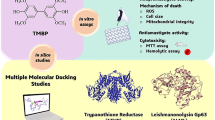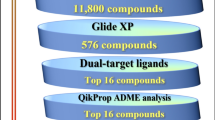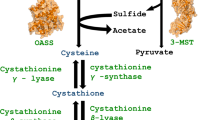Abstract
In the present study, four different natural compounds including quercetin, gallic acid, rutin, and lupeol were studied for their anti-leishmanial potentials with anticipated mechanism of action through in vitro and in silico approaches. Results showed that rutin was exceedingly active (IC50; 91.2 µg/ml) against the promastigote form of Leishmania tropica compared to quercetin (IC50; 182.3 µg/ml), gallic acid (IC50; 198.00 µg/ml) and lupeol (IC50; 200.77 µg/ml). Similarly, rutin was highly active against the amastigote form as well, followed by quercetin, gallic acid and lupeol with IC50 values of 101.3 µg/ml, 137.4 µg/ml, 277.2 µg/ml, and 298.9 µg/ml, respectively. These compounds were found to be nontoxic to human blood erythrocytes even at the highest concentration (1000 µg/ml) tested. Rutin and lupeol showed promising DNA degradation/fragmentation activity against the DNA of treated promastigotes which increased with the increase in concentration of the compounds. The in silico investigation revealed that these ligands have high affinity with the important catalytic residues of trypanothione reductase (Try-R) where, rutin showed the lowest docking score (i.e., − 6.191) followed by lupeol (− 5.799), gallic acid and quercetin. In case of ligands’ interaction with trypanothione synthetase (Try-S), rutin again showed highest interaction with docking score of − 6.601 followed by quercetin (− 4.996), lupeol and gallic acid. The ADMET prediction of these compounds showed that all the parameters were within the acceptable range as defined for human use while molecular dynamics simulation supported the good interaction of quercetin and rutin against both enzymes. These findings suggest that the studied compounds may control leishmanial growth via DNA damage and inhibiting Try-R and Try-S, the two unique but critical enzymes for leishmania growth.







Similar content being viewed by others
References
Ahamad B, Islam A, Khan A, Khan MA, ul Haq I, Ahmad M, Mehwish S, Khan A, Ullah N (2019) Comprehensive investigations on anti-leishmanial potentials of Euphorbia wallichii root extract and its effects on membrane permeability and apoptosis. Comp Immunol Microbiol Infect Dis 64:138–145
Baiocco P, Colotti G, Franceschini S, Ilari A (2009) Molecular basis of antimony treatment in leishmaniasis. J Med Chem 52(8):2603–2612
Bikadi Z, Hazai E (2009) Application of the PM6 semi-empirical method to modeling proteins enhances docking accuracy of AutoDock. J Cheminformatics 1(1):15
Boelaert M, Le Ray D, Van Der Stuyft P (2002) How better drugs could change kala-azar control Lessons from a cost-effectiveness analysis. Trop Med Int Health 7(11):955–959
Case D, Berryman J, Betz R, Cerutti D, Cheatham T III, Darden T, Duke R, Giese T, Gohlke H, Goetz A (2015) AMBER 2015. University of California, San Francisco
Chan-Bacab MJ, Peña-Rodríguez LM (2001) Plant natural products with leishmanicidal activity. Nat Prod Rep 18(6):674–688
Corral MJ, Benito-Peña E, Jiménez-Antón MD, Cuevas L, Moreno-Bondi MC, Alunda JM (2016) Allicin induces calcium and mitochondrial dysregulation causing necrotic death in leishmania. PLoS Negl Trop Dis 10(3):e0004525
Das A, Jawed JJ, Das MC, Sandhu P, De UC, Dinda B, Akhter Y, Bhattacharjee S (2017) Antileishmanial and immunomodulatory activities of lupeol, a triterpene compound isolated from Sterculia villosa. Int J Antimicrob Agents 50(4):512–522
Ebrahimisadr P, Ghaffarifar F, Hassan ZM (2013) In-vitro evaluation of antileishmanial activity and toxicity of artemether with focus on its apoptotic effect. Iran J Pharm Res 12(4):903
Evans BC, Nelson CE, Shann SY, Beavers KR, Kim AJ, Li H, Nelson HM, Giorgio TD, Duvall CL (2013) Ex vivo red blood cell hemolysis assay for the evaluation of pH-responsive endosomolytic agents for cytosolic delivery of biomacromolecular drugs. JoVE (73)
Fairlamb AH, Cerami A (1992) Metabolism and functions of trypanothione in the Kinetoplastida. Ann Rev Microbiol 46(1):695–729
Fonseca-Silva F, Inacio JD, Canto-Cavalheiro MM, Almeida-Amaral EE (2011) Reactive oxygen species production and mitochondrial dysfunction contribute to quercetin induced death in Leishmania amazonensis. PLoS ONE 6(2):e14666
Fyfe PK, Oza SL, Fairlamb AH, Hunter WN (2008) Leishmania trypanothione synthetase-amidase structure reveals a basis for regulation of conflicting synthetic and hydrolytic activities. J Biol Chem 283(25):17672–17680
Gundampati RK, Chandrasekaran S, Jagannadham MV (2013) Molecular docking study on the interaction between trypanothione reductase and mangiferin for antileishmanial activity. Bangladesh J Pharmacol 8:40–43
Hou T (2011) Editorial [Hot topic: in silico predictions of ADME/T properties: progress and challenges (Guest Editor: Tingjun Hou)]. Comb Chem High Throughput Screen 14(5):306
Katsu T, Kobayashi H, Fujita Y (1986) Mode of action of gramicidin S on Escherichia coli membrane. Biochimica et Biophysica Acta (BBA) Biomembranes 860(3):608–619
Khademvatan S, Gharavi MJ, Rahim F, Saki J (2011) Miltefosine-induced apoptotic cell death on Leishmania major and L. tropica strains. Korean J Parasitol 49(1):17
Lindorff-Larsen K, Piana S, Palmo K, Maragakis P, Klepeis JL, Dror RO, Shaw DE (2010) Improved side-chain torsion potentials for the Amber ff99SB protein force field. Proteins Struct Funct Bioinform 78(8):1950–1958
Lipinski CA (2016) Rule of five in 2015 and beyond: target and ligand structural limitations, ligand chemistry structure and drug discovery project decisions. Adv Drug Deliv Rev 101:34–41
Mabkhot YN, Aldawsari FD, Al-Showiman SS, Barakat A, Hadda TB, Mubarak MS, Naz S, Ul-Haq Z, Rauf A (2015) Synthesis, bioactivity, molecular docking and POM analyses of novel substituted thieno [2, 3-b] thiophenes and related congeners. Molecules 20(2):1824–1841
Malavaki CJ, Roussidis AE, Gialeli C, Kletsas D, Tsegenidis T, Theocharis AD, Tzanakakis GN, Karamanos NK (2013) Imatinib as a key inhibitor of the platelet-derived growth factor receptor mediated expression of cell surface heparan sulfate proteoglycans and functional properties of breast cancer cells. FEBS J 280(10):2477–2489
Matassov D, Kagan T, Leblanc J, Sikorska M, Zakeri Z (2004) Measurement of apoptosis by DNA fragmentation. Apoptosis methods and protocols. Springer, Berlin, pp 1–17
mesh Ewald P (1993) An N· log (N) method for Ewald sums in large systems. J Chem Phys 98:10089–10092
Muñozb AFAAV, Roblot F, Hocquemiller R, Cavé A (1992) Biological and chemical studies of Pera benensis, a Bolivian plant used in folk medicine as a treatment of cutaneous leishmaniasis. J Ethnopharniacol 37:159–164
Myler PJ, Fasel N (2008) Leishmania: after the genome. Horizon Scientific Press, Poole
Nadhman A, Nazir S, Khan MI, Ayub A, Muhammad B, Khan M, Shams DF, Yasinzai M (2015) Visible-light-responsive ZnCuO nanoparticles: benign photodynamic killers of infectious protozoans. Int J Nanomed 10:6891
Peitsch MC, Schwede T, Guex N (2000) Automated protein modelling-the proteome in 3D. Pharmacogenomics 1(3):257–266
Ribeiro TG, Nascimento AM, Henriques BO, Chávez-Fumagalli MA, Franca JR, Duarte MC, Lage PS, Andrade PH, Lage DP, Rodrigues LB (2015) Antileishmanial activity of standardized fractions of Stryphnodendron obovatum (Barbatimao) extract and constituent compounds. J Ethnopharmacol 165:238–242
Ryckaert J-P, Ciccotti G, Berendsen HJ (1977) Numerical integration of the cartesian equations of motion of a system with constraints: molecular dynamics of n-alkanes. J Comput Phys 23(3):327–341
Salomon-Ferrer R, Götz AW, Poole D, Le Grand S, Walker RC (2013) Routine microsecond molecular dynamics simulations with AMBER on GPUs. 2. Explicit solvent particle mesh Ewald. J Chem Theory Comput 9(9):3878–3888
Shadab M, Jha B, Asad M, Deepthi M, Kamran M, Ali N (2017) Apoptosis-like cell death in Leishmania donovani treated with KalsomeTM10, a new liposomal amphotericin B. PLoS ONE 12(2):e0171306
Silveira FT, Lainson R, Corbett CE (2004) Clinical and immunopathological spectrum of American cutaneous leishmaniasis with special reference to the disease in Amazonian Brazil: a review. Mem Inst Oswaldo Cruz 99(3):239–251
Vila-Nova NS, Morais SM, Falcão MJ, Bevilaqua CM, Rondon F, Wilson ME, Vieira IG, Andrade HF (2012) Leishmanicidal and cholinesterase inhibiting activities of phenolic compounds of Dimorphandra gardneriana and Platymiscium floribundum, native plants from Caatinga biome. Pesquisa Veterinária Brasileira 32(11):1164–1168
Wang W, Ye W, Jiang C, Luo R, Chen HF (2014a) New force field on modeling intrinsically disordered proteins. Chem Biol Drug Des 84(3):253–269
Wang X, Lim HJ, Son A (2014b) Characterization of denaturation and renaturation of DNA for DNA hybridization. Environ Health Toxicol 29
Ye W, Ji D, Wang W, Luo R, Chen H-F (2015) Test and evaluation of ff99IDPs force field for intrinsically disordered proteins. J Chem Inf Model 55(5):1021–1029
Acknowledgements
The authors highly acknowledge Higher Education Commission of Pakistan for funding the project No: 5192/KPK/NRPU/R&D/HEC/2016.
Author information
Authors and Affiliations
Contributions
SM, HK, OH and MA performed all the invitro and molecular docking study. Dr. AW and Dr. AUK being experts of bioinformatics studies and application helped the students in performing in silico studies and preparing the manuscript. AUR and Dr. MAK performed simulation studies and ADMET analysis. Dr. MAK helped in write up, proof reading the manuscript and improved its English quality. Dr. NU; designed the project, obtained funding, helped SM and HK in writing and submitting the manuscript.
Corresponding author
Ethics declarations
Conflict of interest
On behalf of all authors, the corresponding author declares that there is no conflict of interest.
Rights and permissions
About this article
Cite this article
Mehwish, S., Khan, H., Rehman, A.U. et al. Natural compounds from plants controlling leishmanial growth via DNA damage and inhibiting trypanothione reductase and trypanothione synthetase: an in vitro and in silico approach. 3 Biotech 9, 303 (2019). https://doi.org/10.1007/s13205-019-1826-1
Received:
Accepted:
Published:
DOI: https://doi.org/10.1007/s13205-019-1826-1




